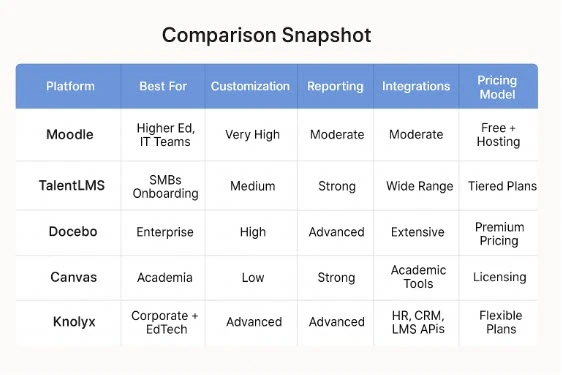Unlocking Success: A Practical Guide to LMS Systems for Business Growth
Published Date: 18 May, 2025
| Updated Date: 17 Jun, 2025
If you’re comparing LMS systems right now, you’re not looking for inspiration. You’re looking for answers.
Maybe the platform you’re using is clunky. Maybe it doesn’t scale. Maybe you’ve outgrown it. Whatever the reason, you know that choosing the wrong LMS costs more than just the budget. It slows down onboarding, frustrates learners, and blocks progress. And with the market full of options, a clear LMS systems comparison is essential.
Whether you’re running digital classrooms or managing company-wide training, the pressure is real: deliver results, keep people engaged, and make the tech work without babysitting it. That’s why a proper LMS systems comparison is the starting point.
The LMS space is overcrowded. And most platforms look the same on the surface. But dig deeper, and you’ll see the gaps, especially when you’re juggling compliance, onboarding, upskilling, or academic outcomes. Choosing the right system isn’t just about features. It’s about finding a tool that fits your context.
Knolyx was built with that in mind. Our approach is rooted in user-centric design: real learning, real people, real results. We’re not throwing around flashy dashboards and calling it innovation. We focus on what actually works in practice.
In this guide, you’ll get a clear LMS systems comparison. We’ll walk through what matters, how different platforms differ, and what separates tools that just check boxes from the best LMS software for long-term growth.
Let’s get into the details and help you make the right call.
Understanding LMS Systems
An LMS isn’t just a tool. It’s an operational layer. Behind every piece of training content, every learning path, every performance report, there’s a system handling the logic. And if that system isn’t built right, everything you build on top of it might not work properly.
A Learning Management System is supposed to make training easier to deliver, easier to manage, and easier to track. It’s the hub for everything, from compliance courses to internal certifications, from academic programs to onboarding flows. The goal is simple: centralize learning, personalize it, and scale it without chaos. When done right, it becomes the foundation that supports growth, performance, and consistency.
But here’s where things get tricky: most platforms check the same boxes on paper. You’ll see “course management,” “tracking,” “mobile access,” and “analytics” listed across the board. But not all implementations are equal. Some systems make content management feel like spreadsheet work. Others bury reporting under ten clicks. That’s the difference between features that exist and features that actually work.
So what should a functioning LMS deliver?
- Course management that doesn’t require an instructional design degree;
- User tracking that’s accurate, detailed, and actually useful;
- Assessments that adapt to learning outcomes, not just throw quizzes at people;
- Mobile compatibility that’s truly mobile;
- Integrations that plug into your HR, CRM, or SIS systems with minimal lift.
The baseline isn’t just checking for features. It’s checking how they perform in real workflows. A meaningful LMS systems comparison is about asking the right questions: How many clicks to assign a course? How flexible are the learning paths? What does reporting look like? Can your team move quickly or are they constantly stuck in workarounds?
And here’s the bigger picture: the landscape won’t wait for anyone. The way people learn at work has changed. Self-paced, mobile-first, hybrid-ready learning is the new default. Regulatory requirements are evolving. Skills gaps are widening. Expectations are high. Meanwhile, your team still has to deliver fast, prove impact, and stay ahead.
That’s why a “set it and forget it” approach is not effective. LMS systems aren’t one-time decisions. They’re evolving ecosystems. If you’re not re-evaluating them regularly, you’re probably building your programs on outdated foundations.
So what does the best LMS software actually look like in this context? It’s the one that doesn’t get in your way. It scales with your team. It simplifies what’s complex. It delivers not just content, but control. And it does all of this without forcing your learners or your admins to fight the system.
That’s what real learning management systems should do.
Criteria for LMS Systems Comparison
Now it’s time to actually break down what separates the best LMS software from the ones that just crowd your inbox with updates and feature drops no one asked for. Here’s how to evaluate platforms that claim to be the top learning management systems.
1. Usability and Interface
Let’s start with the obvious: if your users can’t figure out how to use it, they won’t. A clean, intuitive interface is essential. Admins need to build, assign, and monitor without clicking through endless submenus. Learners should be able to log in, pick up where they left off, and stay focused. The best LMS software understands that UX is about effective functionality.
2. Features and Customization
Most platforms will say they have “everything.” That means nothing until you look at how those features work in your context. Can you actually build courses without external tools? Are assessments flexible or rigid? Can you customize learning paths for different roles or departments? Reporting should be dynamic, not static exports.
3. Integration Capabilities
This is where many systems fall apart. If your LMS doesn’t speak the same language as your HR software, CRM, calendar tools, or identity systems, you’re signing up for a headache. Look for platforms that offer native integrations, open APIs, and SSO compatibility. The goal? Minimize manual work. Maximize interoperability.
4. Pricing and Cost-Effectiveness
Forget base price, focus on total cost to operate. That includes setup, support, upgrades, and internal hours spent wrestling with limitations. Subscription models, per-user licensing, and tiered pricing all have pros and cons depending on your size and growth rate. What you want is value over time, and flexibility without compromise.
5. Customer Support and Training
Even the best-built systems will encounter challenges. When that happens, is support actually available? Is it useful? Can your team get up to speed quickly with training resources, documentation, or a user community that actually answers questions? This part often gets overlooked, until you need it.
Bottom line: if you’re not evaluating these core areas, you’re choosing blind. Every vendor will claim to be the best LMS software, but only a few can prove it where it counts: in day-to-day operations, at scale, with real users.
Pros & Cons Analysis
Now that we’ve understood what to look for, let’s put that framework to work.
Below is a curated breakdown of some of the most widely-used platforms in the market today. These aren’t picked at random, they’re systems that show up consistently in buying cycles across education, corporate training, and hybrid models. It’s a real-world LMS systems comparison, based on how these tools perform when actual teams and institutions start using them.
Moodle
An open-source staple, Moodle is a go-to for academic institutions and teams with strong internal IT support. It’s highly customizable, which makes it flexible, but also resource-heavy.
- Key features: Modular structure, detailed permissions, SCORM compliance, multilingual support.
- Pros: Free to start, massive user community, highly customizable.
- Cons: Steep learning curve, clunky UI, requires technical support.
TalentLMS
Built for business training, TalentLMS is known for being lightweight, user-friendly, and fast to deploy.
- Key features: Course builder, video support, quizzes, reports, integrations with Zoom, Salesforce, and more.
- Pros: Intuitive UI, strong reporting, great for SMBs.
- Cons: Limited customization on lower-tier plans, may not scale well for complex enterprise needs.
Docebo
A more enterprise-focused platform, Docebo balances sleek design with powerful integrations and AI-driven features.
- Key features: Social learning, content suggestions, extensive analytics, third-party marketplace.
- Pros: Clean interface, scalable, flexible API;
- Cons: Premium pricing, feature overload for small teams.
Canvas LMS
Popular in the higher education sector, Canvas offers a modern experience with solid collaborative tools.
- Key features: Discussion forums, mobile app, LTI integrations.
- Pros: Strong mobile UX, reliable performance, cloud-based.
- Cons: Somewhat limited in deep customization compared to other platforms, pricing less competitive for small organizations.
Knolyx
Built for organizations that value flexibility, clarity, and real outcomes, Knolyx focuses on a user-centric design and practical features that translate into adoption.
- Key features: Adaptive learning paths, real-time collaboration tools, granular reporting, SCORM and xAPI support.
- Pros: Intuitive interface, high learner engagement, seamless integrations, responsive support team.
- Cons: Marketplace feature still in development, but it’s coming soon.
There’s no one-size-fits-all here. Each platform has strengths and blind spots. What matters is whether those align with your needs. This is where the top learning management software earns its reputation: in the daily workflow, across real teams.
Choosing the Best LMS Software for Your Needs: Recommendations
When it comes down to it, the question isn’t just “which LMS is good?” It’s about which is best for your specific needs. After all, not all LMS platforms are created equal. A system that works wonders for an academic institution might be too rigid or feature-heavy for a small business trying to onboard a new team. A lightweight, straightforward system might not scale well when you’re trying to roll out training across multiple departments.
The best LMS software doesn’t just offer the right features, it supports your entire learning ecosystem. It helps you onboard faster, develop talent, and scale as your team or institution grows.
When searching for the best LMS, focus on the features that align with your goals. Flexibility, ease of integration, user engagement, and long-term scalability should be your guiding principles. Some platforms excel in academic environments; others shine in the corporate world. But the key takeaway is this: the best LMS is the one that makes sense for your learners, your team, and your bottom line.
Before making a final call, map your priorities, weigh them against what each platform offers, and test it with a free trial or demo. It’s the only way to see if the tool fits your reality, not just the spec sheet.





0 Comments